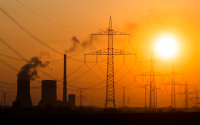20 June 2007John Vidal and David Adam
 Cyclists pass a factory in Yutian in China's north-west Hebei province. Photograph: Peter Parks/AFP
Cyclists pass a factory in Yutian in China's north-west Hebei province. Photograph: Peter Parks/AFP
China's emissions had not been expected to overtake those from the US, formerly the biggest polluter, for several years, although some reports predicted it could happen next year.
But according to figures released yesterday by the Netherlands Environmental Assessment Agency, which advises the Dutch government, soaring demand for coal to generate electricity and a surge in cement production have helped to push China's recorded emissions for 2006 beyond those of the US.
The agency said China produced 6,200m tonnes of CO2 last year, compared with 5,800m tonnes from the US. Britain produced about 600m tonnes. But per head of population, China's pollution remains relatively low, about a quarter of that in the US and half that of the UK.
China's surge to 8% more than the US was helped by a 1.4% fall in the latter's CO2 emissions during 2006, which, analysts say, is down to a slowing US economy.
Jos Olivier, a senior scientist at the agency who compiled the figures, said: "There will still be some uncertainty about the exact numbers, but this is the best and most up to date estimate available. China relies very heavily on coal and all of the recent trends show their emissions going up very quickly."
China's emissions were 2% below those of the US in 2005.
The new figures include only CO2 emissions from fossil fuel burning and cement production. They do not include sources of other greenhouse gases such as methane from agriculture and nitrous oxide from industrial processes.
They exclude other sources of CO2 such as aviation and shipping as well as deforestation, gas flaring and underground coal fires.
Dr Olivier said it was difficult to find reliable estimates for such emissions, particularly from developing countries. But he said including them would be unlikely to topple China from the top spot. "Since China passed the US by 8% [last year] it will be pretty hard to compensate for that with other sources of emissions," he said.
To work out the emissions figures, he used data issued by the oil company BP earlier this month on the consumption of oil, gas and coal across the world during 2006, as well as information on cement production published by the US Geological Survey.
Cement production, which requires huge amounts of energy, accounts for about 4% of global CO2 production from fuel use. China's cement industry, which produces about 44% of world supply, contributes almost 9% of Chinese CO2 emissions.
The announcement came as negotiations to produce a climate treaty to succeed the Kyoto protocol when it expires in 2012 are delicately poised. The US refused to ratify Kyoto partly because it made no demands on China, and a major sticking point of the new negotiations has been finding a way to include both countries, as well as other rapidly developing economies such as India and Brazil. Tony Blair believes the best approach is to develop national markets to cap and trade carbon, which could then be linked.
Earlier this month, China unveiled its first national plan on climate change after two years of preparation by 17 government ministries.
Rather than setting a direct target for the reduction or avoidance of greenhouse gas emissions, it aims to reduce energy consumption per unit of gross domestic product by 20% by 2010 and to increase the share of renewable energy to some 10% as well as to cover roughly 20% of the country's land with forest.
But it stressed that technology and costs are big barriers to achieving energy efficiency. What China needs, said a government spokesman, is international cooperation in helping it move toward a low-carbon economy.
Chinese industries have been hesitant to embrace unproven clean coal technologies which are still in their infancy in developed countries.
http://www.guardian.co.uk/china/story/0,,2106999,00.html?gusrc=rss&feed=12






